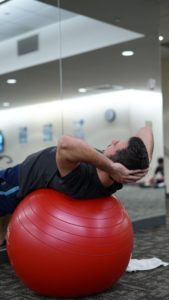Athletes have used cryotherapy and ice water baths for quite some time. What patients do outside of their physical therapist’s office is just as imperative as the therapy itself. Now, physical therapists are recommending this in-clinic and at home treatment for car accident injuries.
How cryotherapy helps heal car accident injuries:
Cryotherapy is not for the faint hearted. However, it is for people that want to relieve aches and pains. Firstly, always get permission from your physical therapist and other doctors that have treated you for your injuries.
Once patients get the go ahead, it is off to the freezing chambers you go. Cryotherapy begins by patients putting on provided cotton shorts and vests. A mask is provided to limit the amount of liquid nitrogen inhaled.
![]() Socks, a headband, and mittens are necessary to protect the smaller body parts which receive less blood flow. Fingers, toes, and ears are susceptible to becoming frozen if uncovered. If patients have any piercings, it is highly recommended to remove them prior to cryochamber as the skin around the metal will freeze if they are not covered.
Socks, a headband, and mittens are necessary to protect the smaller body parts which receive less blood flow. Fingers, toes, and ears are susceptible to becoming frozen if uncovered. If patients have any piercings, it is highly recommended to remove them prior to cryochamber as the skin around the metal will freeze if they are not covered.
Do you remember the old-fashioned method of putting something cold topically to the throbbing area? Cryotherapy takes this traditional approach to a whole new, modern level. The entire body is subjected to sub-zero temperatures.
This practice is also referred to as whole-body cryotherapy although the neck and above are not inside the chamber. Your head and neck peak out of the top section of some chambers, depending on the company. The chamber is filled with liquid nitrogen.
This gas reaches a temperature of negative one hundred twenty degrees Celsius. That is negative one hundred eighty-four degrees Fahrenheit for the Americans. Cold reduces inflammation and helps circulation.
Therefore, this extremely cold chamber provides an unnatural yet quick solution for pain, recovery, and inflammation. Cryotherapy is not a one stop therapy shop. Cryotherapy is just a helping hand during the time of physical therapy or after, if approved by your doctor.
The sequence of events:
Before the “big shot” chamber, you enter the pre-chamber to ease the body into the cold. This mini-chamber is still negative seventy degrees Celsius though which is enough to make a person shiver immediately.
Keep in mind, each cryotherapy business has a different procedure. The company you choose may not have a pre-chamber. People tend to feel claustrophobic inside the chamber. This is due to the liquid nitrogen preventing people from seeing what is in front of them.
Take comfort in knowing that you can open the door and exit at any time. After the timed pre-chamber portion, you enter the real deal chamber. This chamber is set at negative one hundred twenty degrees Celsius.
Of course, it is not unbearable, or else there wouldn’t be a market for it. Although, it is pretty uncomfortable. Your skin may feel a burning sensation because it is so cold. The exposed skin may be bright red, but it is not a cause for concern.
The effects:
 Before the cryotherapy treatment, a normal body’s temperature is around 97 to 99 degrees Fahrenheit. During the treatment, the body temperature usually drops dramatically. After treatment, the body temperature spikes back up. This creates a rapid yet controlled change in body temperature causing great circulation.
Before the cryotherapy treatment, a normal body’s temperature is around 97 to 99 degrees Fahrenheit. During the treatment, the body temperature usually drops dramatically. After treatment, the body temperature spikes back up. This creates a rapid yet controlled change in body temperature causing great circulation.
This incredible circulation fights inflammation, speeds up the metabolism, and can even improve the appearance of the skin. For those who are going through a daunting schedule of physical therapy, cryotherapy may successfully relieve aches and pains. Together, this treatment and physical therapy at ProCare Health & Rehab Centers can greatly impact the healing process of car accident injuries.
Again, consult with your doctor before following through with such extreme treatments. Avoid cryotherapy if you suffer from any condition listed:
- Bleeding disorders
- Thrombosis
- Seizures
- Cardiac disease
- Lung disorders
- Acute kidney infection
- Hypertension
- Acute or recent myocardial infarction
- Arrhythmia
Old fashioned ways:
 Originally, exposure to freezing temperatures for muscle recovery was first popular amongst athletes. Intense exercise creates tiny tears in muscle fibers called micro trauma. These tiny tears are actually the goal of exercise as they promote muscle cell repair.
Originally, exposure to freezing temperatures for muscle recovery was first popular amongst athletes. Intense exercise creates tiny tears in muscle fibers called micro trauma. These tiny tears are actually the goal of exercise as they promote muscle cell repair.
This repairs and strengthens the damaged muscles. This act is related to delayed onset muscle pain and soreness, DOMS. The aches and pains occur twenty-four to seventy-two hours after exercise.
An ice bath constricts blood vessels and flush waste products. They reduce swelling and tissue breakdown as well as decrease metabolic activity. Exiting an ice bath and rewarming the body promotes blood flow and is believed to speed up circulation which improves the healing process.
Cryotherapy has come a long way with reducing the time needed for this outrageous cold exposure therapy. We hope this treatment may aid your healing process. Discuss with your doctor before trying any new treatments.
Make an appointment today to see our physicians at ProCare Health & Rehab Centers in Oviedo, FL to heal any car accident injury. Stop by next week for more!
Staff Writer



